
Grant Locomotive Works was a manufacturer of steam railway locomotives from 1867 to 1895, first in Paterson, New Jersey, and then in Chicago. The company built about 1,888 locomotives. [1]

Grant Locomotive Works was a manufacturer of steam railway locomotives from 1867 to 1895, first in Paterson, New Jersey, and then in Chicago. The company built about 1,888 locomotives. [1]
In 1842, Samuel Smith, Abram Collier, and George Bradley started a small foundry in Paterson. In 1848, Smith sold his interest to Collier and formed a new partnership with his brother, William C. Smith, Henry Whitely, and Thomas Beggs. Beggs died soon thereafter and William Smith and Whitely sold their interests. William Swinburne, who had been superintendent at Rogers Locomotive Works bought Beggs's interest. The firm was renamed Swinburne, Smith and Company. In 1848, it took an order for ten locomotives for the New York and Erie Railroad; three years later, it received a corporate charter as New Jersey Locomotive and Machine Company.
In 1863-64, Oliver De Forest Grant bought the stock and ran the business with his sons, David B. Grant and R. Suydam Grant. The father died shortly thereafter and David Grant took over as president. [2]


The namesake of the 2-8-0 Consolidation type was designed in 1866 by Alexander Mitchell, Master Mechanic of the Mahanoy Division of the Lehigh Valley Railroad. Baldwin Locomotive Works was asked to build it, but was reluctant; Rogers Locomotive Works declined. Grant submitted a bid of $19,500, but ultimately the contract went to Baldwin. [3] Fifteen years later, in 1881, the Baldwin Locomotive Works was unable to fill an order of Consolidations from the Denver & Rio Grande Western Railroad, and part of the contract went to Grant to build that railroad's C-16-60N (better known as C-16)-class locomotives. One of the two surviving Grant-built locomotives, D&RGW 223, was built to this Consolidation design. [4]
In 1867, the business was granted a New Jersey corporate charter as Grant Locomotive Works. The business muddled along, "rarely enjoying continuing financial success". [3] The company's boilermakers struck for higher wages in 1872; Grant locked them out and eventually replaced them for less money. In 1874, the Russian Empire ordered 55 Consolidations, but difficulties arose and ultimately the Russians canceled 20 of the order.
Grant retired on January 1, 1880, and was succeeded by William W. Evans, who had been chief accountant since 1866. Two years later, the company had 720 men on the payroll. In 1881, the company completed 110 engines. In 1882, the company owned 157,000 square feet (14,600 m2) of manufacturing and office space in nine buildings, of which it occupied 126,665 square feet (11,767.6 m2). [2] In 1887, the company lost half of its buildings in a fire. [1]
A group of Chicago businessmen convinced the company to move there. They spent more than a million dollars on buildings and installed largely new machinery, bringing only certain patterns from Paterson. The company built only 24 engines in Chicago before a strike and the Panic of 1893 forced it into receivership, from which it did not recover. [1]
The company built locomotives for at least 134 domestic railroads, including:
Until the early 1870s, these were largely Americans (4-4-0s), with a few six-wheel switchers (0-6-0s), Moguls (2-6-0s), and Ten Wheelers (4-6-0)s. In 1865, the firm built 22 eight-wheel switchers (0-8-0s) for the B&O. The order for the Russian government was apparently the firm's first 2-8-0s. In 1878, it built 35 Columbias (2-4-2s) for the Manhattan elevated railway. From 1878 to 1882, it built 96 Consolidations for the New York, Lake Erie & Western. Their first three-foot-gauge order came from the Utah Northern, a narrow-gauge line that ran from Ogden, Utah, to Butte, Montana. These locomotives, of the 2-4-0 type, were delivered in 1871. [5] In 1881, the Denver and Rio Grande ordered 30 narrow-gauge Consolidations of the 60N (later C-16) class. Their next narrow-gauge order was 20 engines for the Toledo, Cincinnati & St. Louis R.R., which defaulted on payment. Grant was forced to sell them at a large loss that weakened the company's finances. [1] In 1887, shortly before the fire destroyed much of their factory the company secured a single order (works no. 1713 according to the Best list ) for a 2-6-2 "Prairie" tank locomotive for the Chinese Engineering & Mining Company's Kaiping colliery at Tangshan, N.E. China. This was allocated the mine's road No.4. The locomotive's wheel arrangement and other specifications broadly matched two similar batches of British locomotives ordered at the same time from the Dubs and the Sharp Stewart locomotive works respectively , both based in Glasgow, Scotland. [6] [7] A photograph of this engine has survived

The Denver and Rio Grande Western Railroad, often shortened to Rio Grande, D&RG or D&RGW, formerly the Denver & Rio Grande Railroad, was an American Class I railroad company. The railroad started as a 3 ft narrow-gauge line running south from Denver, Colorado, in 1870. It served mainly as a transcontinental bridge line between Denver, and Salt Lake City, Utah. The Rio Grande was also a major origin of coal and mineral traffic.

A transcontinental railroad or transcontinental railway is contiguous railroad trackage, that crosses a continental land mass and has terminals at different oceans or continental borders. Such networks can be via the tracks of either a single railroad or over those owned or controlled by multiple railway companies along a continuous route. Although Europe is crisscrossed by railways, the railroads within Europe are usually not considered transcontinental, with the possible exception of the historic Orient Express. Transcontinental railroads helped open up unpopulated interior regions of continents to exploration and settlement that would not otherwise have been feasible. In many cases they also formed the backbones of cross-country passenger and freight transportation networks. Many of them continue to have an important role in freight transportation and some like the Trans-Siberian Railway even have passenger trains going from one end to the other.

A 2-8-8-4 steam locomotive, under the Whyte notation, has two leading wheels, two sets of eight driving wheels, and a four-wheel trailing truck. The type was generally named the Yellowstone, a name given it by the first owner, the Northern Pacific Railway, whose lines ran near Yellowstone National Park. Seventy-two Yellowstone-type locomotives were built for four U.S. railroads.

The California Zephyr was a passenger train that ran between Chicago, Illinois and Oakland, California via Omaha, Denver, Salt Lake City, Winnemucca, Oroville and Pleasanton. It was operated by the Chicago, Burlington & Quincy (CB&Q), Denver & Rio Grande Western (D&RGW) and Western Pacific (WP) railroads, all of which dubbed it "the most talked about train in America" on March 19, 1949, with the first departure the following day. The train was scheduled to pass through the most spectacular scenery on its route in the daylight. The original train ceased operation in 1970, though the D&RGW continued to operate its own passenger service, the Rio Grande Zephyr, between Salt Lake City and Denver, using the original equipment until 1983. In 1983 a second iteration of the California Zephyr, an Amtrak service, was formed. The current version of the California Zephyr operates partially over the route of the original Zephyr and partially over the route of its former rival, the City of San Francisco.
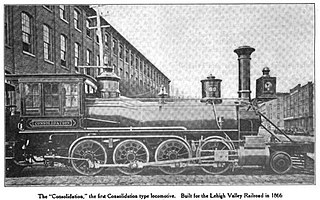
Under the Whyte notation for the classification of steam locomotives, 2-8-0 represents the wheel arrangement of two leading wheels on one axle, usually in a leading truck, eight powered and coupled driving wheels on four axles, and no trailing wheels. In the United States and elsewhere, this wheel arrangement is commonly known as a Consolidation, after the Lehigh and Mahanoy Railroad’s Consolidation, the name of the first 2-8-0.
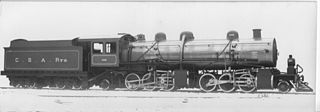
Under the Whyte notation for the classification of steam locomotives by wheel arrangement, a 2-6-6-2 is a locomotive with one pair of unpowered leading wheels, followed by two sets of three pairs of powered driving wheels and one pair of trailing wheels. The wheel arrangement was principally used on Mallet-type articulated locomotives, although some tank locomotive examples were also built. A Garratt type locomotive with the same wheel arrangement is designated 2-6-0+0-6-2.
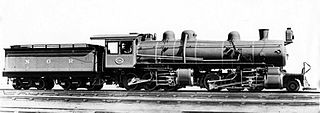
Under the Whyte notation for the classification of steam locomotives by wheel arrangement, 2-6-6-0 is a locomotive with one pair of unpowered leading wheels, followed by two sets of three pairs of powered driving wheels and no trailing wheels. The wheel arrangement was principally used on Mallet-type articulated locomotives. Some tank locomotive examples were also built, for which various suffixes to indicate the type of tank would be added to the wheel arrangement, for example 2-6-6-0T for an engine with side-tanks.

The Durango and Silverton Narrow Gauge Railroad, often abbreviated as the D&SNG, is a 3 ft (914 mm) narrow-gauge heritage railroad that operates on 45.2 mi (72.7 km) of track between Durango and Silverton, in the U.S. state of Colorado. The railway is a federally-designated National Historic Landmark and was also designated by the American Society of Civil Engineers as a National Historic Civil Engineering Landmark in 1968.
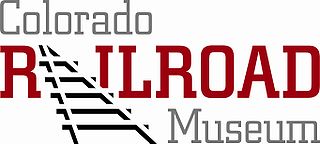
The Colorado Railroad Museum is a non-profit railroad museum. The museum is located on 15 acres (6.1 ha) at a point where Clear Creek flows between North and South Table Mountains in Golden, Colorado.

The Ghost Town & Calico Railway is a 3 ft narrow-gauge heritage railroad and amusement park attraction within Knott's Berry Farm, an amusement park located in Buena Park, California.

The Southern San Luis Valley Railroad is a fallen flag shortline railroad that was located in Southern Colorado. Best known in its final years of operation, it served a connection with the Denver and Rio Grande Western Railroad at Blanca, Colorado. The diminutive railroad in its final form was approximately 1.53 miles (2.46 km) in length. During its life freight traffic included farm produce, fertilizer and volcanic scoria. The railroad, as it was originally built, was 31 miles (50 km) long and besides freight it operated passenger service between Blanca and Jaroso, Colorado, until 1946. The railroad formally ceased all operations December 31, 1996.

Standard gauge was favored for railway construction in the United States, although a fairly large narrow-gauge system developed in the Rocky Mountains of Colorado and Utah. Isolated narrow-gauge lines were built in many areas to minimize construction costs for industrial transport or resort access, and some of these lines offered common carrier service. Outside Colorado, these isolated lines evolved into regional narrow-gauge systems in Maine, New York, Pennsylvania, Ohio, Iowa, Hawaii, and Alaska.

The Denver and Rio Grande Western K-27 is a class of 3 ft narrow gauge 2-8-2 "Mikado" type steam locomotives built for the Denver and Rio Grande Railroad by the Baldwin Locomotive Works in 1903. Known by their nickname "Mudhens," they were the first and the most numerous of the four K classes of Rio Grande narrow gauge engines to be built. Of the original fleet of 15 locomotives, two survive to this day and operate on heritage railways in the United States. No. 463 is operational on the Cumbres and Toltec Scenic Railroad (C&TSRR) in Chama, New Mexico and No. 464 is currently out of service due to a rebuild on the Huckleberry Railroad in Genesee Township, Michigan.

The Utah Division of the former Denver & Rio Grande Western Railroad (D&RGW) is a rail line that connects Grand Junction, Colorado and Salt Lake City, Utah in the Western United States. It is now incorporated into the Union Pacific Railroad (UP) system as part of the Central Corridor. The modern Union Pacific has split the line into two subdivisions for operational purposes, the Green River Subdivision between Grand Junction and Helper, Utah and the Provo Subdivision from Helper to Salt Lake City. Daily passenger service is provided by Amtrak's California Zephyr; the BNSF Railway and Utah Railway have trackage rights over the line.

The Denver and Rio Grande Western K-28 is a class of ten 3 ft gauge narrow gauge 2-8-2 "Mikado" type steam locomotives built in 1923 by the Schenectady Locomotive Works of the American Locomotive Company (ALCO) for the Denver & Rio Grande Railroad. They were the first new narrow gauge locomotives ordered by the railroad since 1903. They initially comprised class E-4-148-S, but were reclassified K-28 in 1924 when the railroad reorganized into the Denver & Rio Grande Western Railroad.

Denver and Rio Grande Western No. 169 is a 4-6-0 "Ten Wheeler" type narrow gauge steam railway locomotive. It is one of twelve similar locomotives built for the Denver and Rio Grande Railroad by Baldwin Locomotive Works in 1883. It was built as a passenger locomotive, with 46 in (1,200 mm) drivers, the second largest drivers used on any three foot gauge D&RGW locomotive.

Denver and Rio Grande Western No. 168 is a class "T-12" 4-6-0 “Ten Wheeler” type narrow-gauge steam railway locomotive. It is one of twelve similar locomotives built for the Denver and Rio Grande Railroad (D&RG) by the Baldwin Locomotive Works in 1883. It was built as a passenger locomotive, with 46 in (1,200 mm) drivers, the largest drivers used on any three foot gauge D&RGW locomotive. The large drivers made it suitable for relatively fast passenger service.
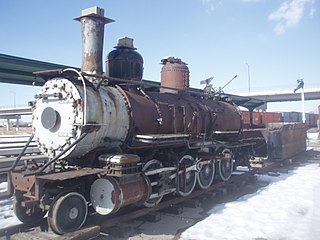
Denver and Rio Grande Western 223 is a 2-8-0 "Consolidation" type narrow-gauge steam railway locomotive built for the Denver and Rio Grande Railroad by the Grant Locomotive Works of Paterson, New Jersey in 1881-82. Number 223 was completed in December 1881, at a cost of $11,553. Baldwin built an additional 25 locomotives in the same class at the same time.
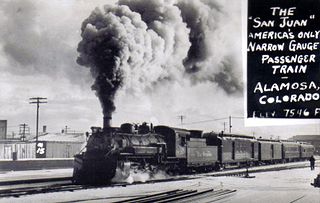
The San Juan Express was a narrow gauge train that ran on the 3 feet (0.91 m) Denver & Rio Grande Western Railroad (D&RGW) route from Durango, Colorado via Chama, New Mexico; Cumbres Pass; and Antonito, Colorado to Alamosa, Colorado. The train ran from February 11, 1937 until January 31, 1951 as train numbers 115 and 116, though towards the end of the passenger service it took on the number 215 and 216.

The Alamosa–Durango line or San Juan extension was a railroad line built by the Denver and Rio Grande Western Railroad, following the border between the U.S. states of Colorado and New Mexico, in the Rocky Mountains. The line was originally built as a 3 ft narrow-gauge line between Alamosa, Colorado, and Durango, Colorado. Portions of the route survive to this day: the now standard-gauged segment from Alamosa to Antonito, Colorado, and a narrow-gauge portion from Antonito to Chama, New Mexico.